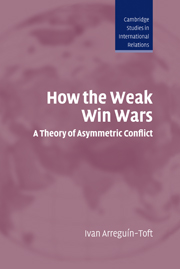Book contents
- Frontmatter
- Contents
- List of figures
- Preface
- Acknowledgments
- List of abbreviations
- 1 Introduction
- 2 Explaining asymmetric conflict outcomes
- 3 Russia in the Caucasus: the Murid War, 1830–1859
- 4 Britain in Orange Free State and Transvaal: the South African War, 1899–1902
- 5 Italy in Ethiopia: the Italo-Ethiopian War, 1935–1940
- 6 The United States in Vietnam: the Vietnam War, 1965–1973
- 7 The USSR in Afghanistan: the Afghan Civil War, 1979–1989
- 8 Conclusion
- Appendix
- References
- Index
- CAMBRIDGE STUDIES IN INTERNATIONAL RELATIONS
2 - Explaining asymmetric conflict outcomes
Published online by Cambridge University Press: 22 August 2009
- Frontmatter
- Contents
- List of figures
- Preface
- Acknowledgments
- List of abbreviations
- 1 Introduction
- 2 Explaining asymmetric conflict outcomes
- 3 Russia in the Caucasus: the Murid War, 1830–1859
- 4 Britain in Orange Free State and Transvaal: the South African War, 1899–1902
- 5 Italy in Ethiopia: the Italo-Ethiopian War, 1935–1940
- 6 The United States in Vietnam: the Vietnam War, 1965–1973
- 7 The USSR in Afghanistan: the Afghan Civil War, 1979–1989
- 8 Conclusion
- Appendix
- References
- Index
- CAMBRIDGE STUDIES IN INTERNATIONAL RELATIONS
Summary
I'm a speed demon, I'm a brain fighter, I'm scientific, I'm artistic, I plan my strategy. He's a bull, I'm a matador …
Muhammad Ali, Zaire (1974) in Gast (1996)[T]aking practical account of the area we wished to deliver … I began idly to calculate how many square miles: sixty: eighty: one hundred: perhaps one hundred and forty thousand square miles. And how would the Turk defend all that? No doubt by a trench line across the bottom, if we came like an army with banners; but suppose we were (as we might be) an influence, an idea, a thing intangible, invulnerable, without front or back, drifting about like a gas? Armies were like plants, immobile, firm-rooted, nourished through long stems to the head. We might be a vapour, blowing where we listed. Our kingdoms lay in each man's mind; and as we wanted nothing material to live on, so we might offer nothing material to the killing. It seemed a regular soldier might be helpless without a target, owning only what he sat on, and subjugating only what, by order, he could poke his rifle at.
T. E. Lawrence (1926)Actors in a conflict of interests each come to that conflict with three things: (1) an estimate of the resources immediately available to fight with, relative to a potential adversary's; (2) a plan for the use of those resources in pursuit of a specified objective (strategy); and (3) an estimate of resources potentially available once the battle has been joined (again, relative to a potential adversary's).
- Type
- Chapter
- Information
- How the Weak Win WarsA Theory of Asymmetric Conflict, pp. 23 - 47Publisher: Cambridge University PressPrint publication year: 2005



